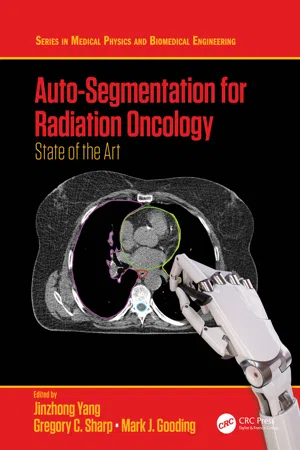Jinzhong Yang , Gregory C. Sharp , and Mark J. Gooding
1.1 Introduction
In the past two decades, the advancement in radiation therapy has allowed delivery of radiation to the treatment target with optimized spatial dose distribution that minimizes radiation toxicity to the adjacent normal tissues [1, 2]. In particular, with the advent of intensity modulated radiation therapy (IMRT) [1], fast and accurate delineation of targets and concerned organs at risk (OARs) from computed tomography (CT) images is extremely important for treatment planning in order to achieve a favorable dose distribution for treatment. Traditionally, these structures are manually delineated by clinicians. This manual delineation is time-consuming, labor intensive, and often subject to inter- and intra-observer variability [3, 4]. With the technology development in medical imaging computing, as well as the availability of more and more curated image and contour data, auto-segmentation has become increasingly available and important in radiation oncology to provide fast and accurate contour delineation in recent years. More and more auto-segmentation tools have been gradually used in routine clinical practice.
1.2 Evolution of Auto-Segmentation
The improvement in the performance of auto-segmentation algorithms has evolved alongside the capability of the algorithms to use prior knowledge for new segmentation tasks [5]. In the early stages of development, limited by the computer power and the availability of segmented data, most segmentation techniques used no or little prior knowledge, relying on the developer to encode their belief in what would provide good segmentation. These methods are referred to as low-level segmentation approaches. Methods include intensity thresholding, region growing, and heuristic edge detection algorithms [6–8]. More advanced techniques were developed in an attempt to avoid heuristic approaches leading to the introduction of uncertainty models and optimization methods. Region-based techniques, such as active contours, level-sets, graph cuts, and watershed algorithms, have been used in medical imaging auto-segmentation [9–12]. Probability-based auto-segmentation techniques, such as Gaussian mixture models, clustering, k-nearest neighbor, and Bayesian classifiers, rose in popularity with the turn of the century thanks to the availability of higher computing power [13, 14]. These techniques employ a limited quantity of prior knowledge in the form of statistical information about each organ’s appearance acquired from example images.
In the last two decades, a large amount of exploratory work has been invested in making better use of prior knowledge, such as shape and appearance characteristics of anatomical structures, to compensate for insufficient soft tissue contrast of CT data which prevents accurate boundary definition using low-level segmentation methods. The approaches can be grouped as (multi)atlas-based segmentation, model-based segmentation, and machine learning-based segmentation [15], taking into account prior knowledge using differing techniques and to differing extents.
Single atlas-based segmentation uses one reference image, referred to as an atlas, in which structures of interest are already segmented, as prior knowledge for new segmentation tasks [16]. The segmentation of a new patient image relies on deformable registration, finding the transformation between the atlas and the patient image to map the contours from the atlas to the patient image. Various deformable registration algorithms have been used for this purpose [17–22], with intensity-based algorithms being popular to achieve full automation. The segmentation performance largely depends on the performance of deformable registration, which, in turn, depends on the similarity of the morphology of organs of interest between the atlas and the new image. To achieve good segmentation results, varied atlas selection strategies have been proposed [23–29]. Alternatively, using an atlas that reflects the anatomy of an average patient can potentially improve segmentation performance [30, 31].
Atlas-based segmentation is also impacted by the inter-subject variability since inaccurate contouring in the atlas will be propagated to the patient image. Instead of using a single atlas, multi-atlas approaches use a number of atlases (normally around ten) as prior knowledge for segmentation of new images [32–37]. Similar to single atlas-based approaches, deformable registration is used to map atlas contours from each atlas to the patient image. Then an additional step, frequently referred as to label/contour fusion, is performed to combine the individual segmentations from each atlas to produce a final segmentation that is the best estimate of the true segmentation [29, 38–41]. Multi-atlas segmentation has been shown to minimize the effects of inter-subject variability and improve segmentation accuracy over single atlas approaches. In the past decade, multi-atlas segmentation has been one of the most effective segmentation approaches in different grand challenges [42–44]. This approach has been validated for clinical radiation oncology applications in contouring normal head and neck tissue [45], cardiac substructures [46], and brachial plexus [34], among others. Commercial implementation of multi-atlas segmentation is also available from multiple vendors [15]. Part I of this book focuses on multi-atlas segmentation, particularly considering atlas selection strategies, deformation registration choice, and the impact of label/contour fusion.
When more contoured images are available, characteristic variations in the shape or appearance of structures of interest can be used for auto-segmentation. Statistical shape models (SSM) or statistical appearance models (SAM) can model the normal range of shape or appearance using a training set of atlases. These approaches have the benefit, compared to atlas-based methods, of restricting the final segmentation results to anatomically plausible sha...
